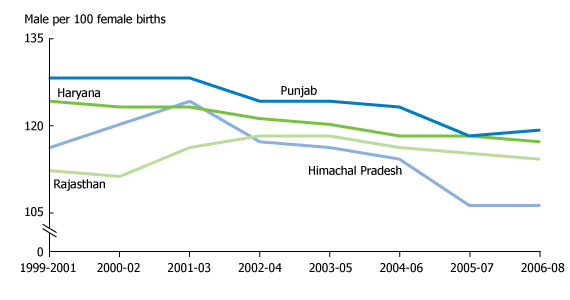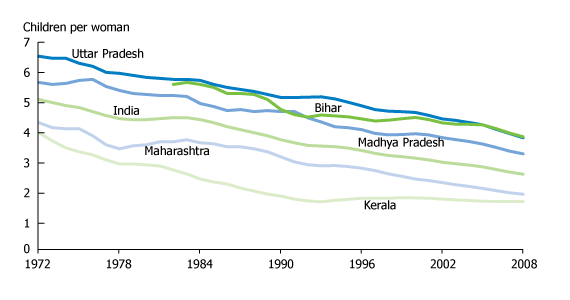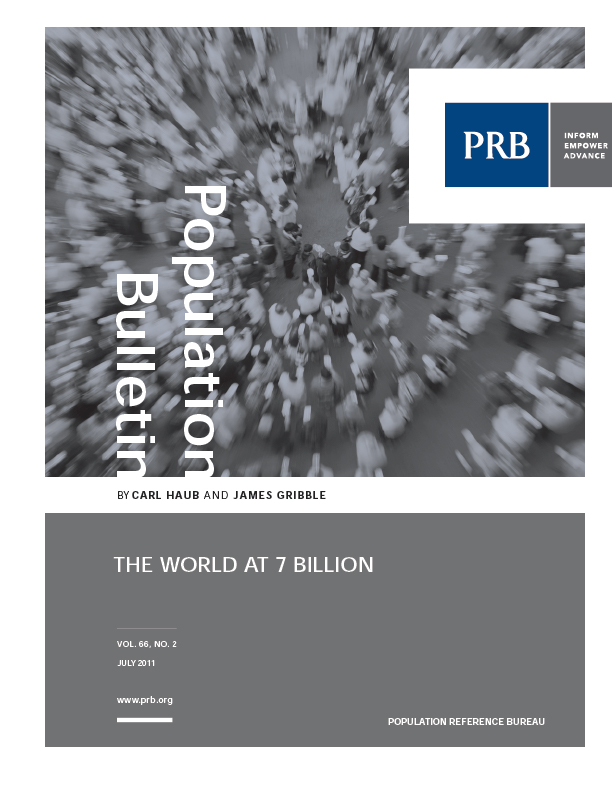
India: On the Path to Replacement?
Date
July 15, 2011
Author
Focus Areas
This article is taken from the Population Bulletin:The World At 7 Billion, which looks at the four phases of the demographic transition as descriptive of past and future population growth. Four countries are highlighted to illustrate each phase and its implications for human well-being.
India is on track to become the world’s largest country about 10 years from now, even though fertility has declined to 2.6 children per woman, which is less than half of its 1950s level.
India’s population will surpass China’s, assuming that China does not alter its current fertility policy. But India’s population will also be more youthful than China’s and will not face a budget-straining situation of population aging. Countries like India in the third phase of demographic transition have fertility rates that have declined significantly from previously high levels but have not reached the population-stabilizing “replacement level” of 2.1 children per woman. These countries are home to 38 percent of the world’s 7 billion people.
Overview
As of the recently conducted 2011 Census, India’s population stood at 1.2 billion. To get an idea of the size of India’s population, consider that the population of just one age group, males ages 0-4, is about 67 million, larger than the entire population of France. Between the last three censuses, India’s population growth rate has been in decline, but the 2011 Census was the first to show a decrease in the number added as well. From 2001 to 2011, 181.5 million people were added, down slightly from 182.3 million from 1991 to 2001.
Figure 1
Sex Ratio at Birth, Selected States of India, 1999-2008

Source: Registrar General of India, Sample Registration System.
India is often portrayed as an exploding middle-class economy. While not a complete exaggeration, such attitudes obscure a far more complex society. Unlike Vietnam, an example of a virtually homogeneous country with a common language and predominant ethnicity, India is more like a collection of semi-independent countries united under one democracy. The country is divided into 35 states and Union Territories, from Uttar Pradesh with 200 million people to the Lakshadweep Islands with 64,429 people. Its diversity is reflected by the fact that there are 16 separate languages on rupee notes. Many states are ruled by regional parties, posing challenges to the national government in Delhi in forming coalition governments at the national level and at some state levels.
Despite much publicity given to the country’s economic growth, India remains a rural nation with many towns officially designated as urban still retaining much of their rural character. Urban places are generally defined as villages and towns of 5,000 or more in which 75 percent or more of the male labor force is not directly employed in agriculture. The average Indian resided in a village of about 4,000 people in 2001. Many of these places lack adequate sanitation and clean water, and are often only reachable by primitive roads and trails. These characteristics often place considerable obstacles in the path of health services delivery.
There are also misconceptions regarding the Indian “middle class” and standards of living. Indians are not consumers in the Western sense of impulse purchases or frivolous spending. A true middle-class Indian, living a Western-standard life, is more properly considered part of the super-rich class, a minuscule proportion of the population. Media reports on new, glitzy shopping malls in India fail to mention that few visitors actually purchase anything; they go to the air-conditioned malls to visit food courts and attend the cinema. In the vast majority of Indian households, traditional ways of life, such as arranged and early marriages (about half of Indian females marry below the legal age of 18), deep respect for one’s elders, and close relations with extended families are the rule. One’s wages are less important than in the West, since large extended families often pool resources.
Figure 2
Total Fertility Rates, India and Selected States, 1972-2009

Note: The states of Chhattisgarh, Jharkhand, and Uttarkhand were seperated from Madhya Pradesh, Bihar, and Uttar Pradesh, respectively, in 2000.
Source: Registrar General of India, Sample Registration System.
Population and Policy
India is often noted as the first developing country to declare a policy to reduce fertility, in 1952, although effective funds were not allocated until 1966 and the fi rst truly comprehensive policy was not written until 2000. Nonetheless, effective measures were taken in many states to lower the birth rate and every state has seen a decline. In the early 1950s, fertility is estimated to have been 5.9 children per woman by the United Nations Population Division, not as high as in many other developing countries at the time where the average was often seven children or more.
By 2009, fertility in India had declined to 2.6 children per woman, less than half that of the early 1950s. But this national fertility rate masks wide disparities by state. The lowest fertility rates are found in the southern states, especially in Kerala with a 2009 TFR of 1.7, along with its neighbor Tamil Nadu. Much of the country’s demographic future will depend on fertility trends in the northern states which, along with large populations, have the highest levels of illiteracy and poverty. Bihar and Uttar Pradesh, the states with the highest TFRs, had populations of 104 million and 200 million, respectively, in 2011. These two states, part of the Empowered Action Group States (EAG), along with Chhattisgarh, Jharkhand, Madhya Pradesh, Orissa, Rajasthan, and Uttarakhand, are all impoverished and are the focus of increased family planning efforts.
Skewed Sex Ratio at Birth
Along with China and several Caucasus countries, the preference for sons in India has resulted in a sex ratio at birth skewed in favor of males. Worldwide, the biological norm is about 105 male per 100 female births. India’s sex ratio is 111 male per 100 female births. In India, there are both economic and religious motivations for the abortion of female fetuses. At marriage, a daughter leaves the household to live with her in-laws and thereby provides no economic support to her parent’s family, especially in their old age. Additionally, a dowry must be paid even though dowries were banned in 1961. There is a saying that having a daughter is “like watering your neighbor’s garden.” For Hindus (about 80 percent of the population), having a son light his parent’s funeral pyre is a prerequisite for Nirvana, the release from the cycle of reincarnation.
Sex-selective abortion was made illegal in 1994 and, recently, the prosecution of doctors who engage in the practice was taken up in a serious way. It is clear that some notable progress has been made. Generally, the abortion of female fetuses is more prevalent in wealthier, highly educated, low-fertility states where parents can afford the ultrasound test and the motivation to have at least one son is more pressing.
The Future
The size of India’s future population will largely depend upon the course of fertility decline in the highly populous north. While clearly in the third phase of the transition, will India move to the fourth phase of replacement fertility or will it join that group of developing countries where that seems doubtful? For the fourth phase to begin, fertility in the very large and poor Indian states will have to decline to that of an industrialized country, around two or fewer children. In terms of future world population size, India will be one of the important demographic stories in coming decades.
Previous: Phase 2: Guatemala: Beyond the Early Stage of the Transition
Next: Phase 4: Germany: Beyond the Transition’s End

 ">
">





